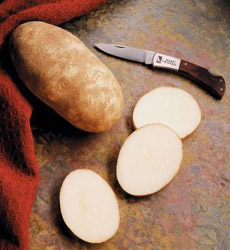RECIPE: Twice Baked Pumpkin Potatoes
|
This recipe for Twice Baked Potatoes offers a new twist by mixing pumpkin in with the scooped-out potato flesh. The result is more complex flavor and more creamy texture—not to mention a bright orange color. There are also a trio of onion varieties: green onions, shallots and yellow onions.
The recipe is from Taylor Mathis of TaylorTakesATaste.com for GoBoldWithButter.com. He recommends it as “a perfect side for any grilled or roasted pork dish.” Ditto for roast chicken. Taylor, a professional food and lifestyle photographer, works with his mother Sally James Mathis, a professional recipe developer. You can bet that everything they create is delicious. RECIPE: TWICE BAKED PUMPKIN POTATOES Ingredients For 8 Servings |
 The center is scooped from baked potatoes, mixed with pumpkin, returned to the potato shell and baked again. Photo courtesy Taylor Mathis | Go Bold With Butter. |
|
|
1. PREHEAT the oven to 42°F and bake the potatoes: Pierce each raw potato three or four times with a fork. Brush with a bit of olive oil, sprinkle with salt and pepper, place and directly on the oven rack. Roast until the skin is crisp and the body is very soft when squeezed, 50–60 minutes. Lower the heat to 350°F. 2. SPLIT the baked potatoes in half lengthwise while still warm. Scoop out the insides of each half, taking care not to damage the skins, and place the flesh in a large bowl. The hollowed-out potato skins will be filled later. 3. MELT the butter in a medium pan. Add the yellow onions, shallots and scallions. Cook, while stirring, until soft. Add the canned pumpkin and milk. Stir until all ingredients are well incorporated. 4. REDUCE the heat and add the salt, pepper and nutmeg. Stir and remove from the heat. Add the Parmesan and stir. Fold the pumpkin mixture into the large bowl of potatoes. 5. FILL the empty potato shells with the potato and pumpkin mixture. Garnish with additional Parmesan and pumpkin seeds as desired. Bake for 15-20 minutes until the cheese is melted and golden brown. |
||
|
|
ABOUT RUSSET POTATOES Russets are the most common type of potato grown in the U.S. They are the classic baking potato, floury/starchy potatoes that are lower in moisture (drier) and high in starch. The potato is oval and has a brown or russet-colored, net-like skin. The skin typically has just a few shallow eyes. The term “Idaho potatoes” is often used interchangeably, but Idaho© Potatoes is a trademark of the Idaho Potato Commission, for russets that are grown in the state of Idaho. Floury potatoes do not hold their shape well after cooking due to their low sugar content. They have a crumbly texture that tends to fall apart when boiled. That’s why russets are easier to mash. In addition to baked potatoes, they’re also used for deep-frying (for example, French fries and potato pancakes). Russets are bred to be harvested in the warmer months; Idahos are harvested in the cooler months. Idahoan Luther Burbank developed the Russet Burbank potato in 1872, a more disease-resistant version of the Irish russet potato. |
|
|
There have been additional russet developments since. In the U.S. alone, they include Alturas, BelRus, Centennial Russet, Century Russet, Frontier Russet, Goldrush, Hilite Russet, Krantz, Lemhi Russet, Nooksack, Norgold Russet, Norking Russet, Ranger Russet, Russet Burbank, Russet Norkotah and Russet Nugget. Each is bred for optimal growing in different soils, climates, rainfalls and seasons, and for resistance to pests. POTATO HISTORY Wild potatoes are indigenous to the Andes Mountains in Peru, where the Incas cultivated many species of potato. They were first domesticated more than 6,000 years ago. The name is said to originate from the Spanish patata, a combination of batata (sweet potato) and papa, a word for potato from the Inca Quechua language. The Spanish conquered Peru around 1530 and brought potatoes back home to Spain along with tomatoes, also native to Peru. News traveled fast (or what passed as “fast” in the centuries prior to the telegraph), and potatoes quickly reached the rest of Western Europe. However, not everyone was enamored of the potato or the tomato. They were feared at first, accused of causing leprosy and being poisonous. They were classified as members of the Nightshade family, Solanaceae, because both contain toxic compounds known as glycoalkaloids. However, the levels in domestic potatoes and tomatoes fall far short of being harmful to people. Slowly, more countries realized the power of the potato. It could grow in any climate. It became a major food crop in Ireland, so much so that when the country was hit by a potato blight (Phytophthora infestans) three years in a row, more than a million people died of starvation and disease. Potatoes were introduced to America in the 18th century. They were first planted in Idaho in 1836; today the state grows 25% of the nation’s potatoes. See the other types of potatoes in our Potato Glossary. |
||



